Olm
Proteus anguinus
This is the only European vertebrate that lives its entire life in a cave.
Advertisement
Olm Scientific Classification
- Kingdom
- Animalia
- Phylum
- Chordata
- Class
- Amphibia
- Order
- Caudata
- Family
- Proteidae
- Genus
- Proteus
- Scientific Name
- Proteus anguinus
Read our Complete Guide to Classification of Animals.
Olm Conservation Status
Olm Facts
- Main Prey
- Insects, insect larvae, worms, small fish, mollusks
- Name Of Young
- Larva, tadpole
- Group Behavior
- Flocks
- Fun Fact
- This is the only European vertebrate that lives its entire life in a cave.
- Estimated Population Size
- Several hundred
- Biggest Threat
- Pollution, human activity, habitat fragmentation
- Most Distinctive Feature
- Its long lifespan
- Distinctive Feature
- Elongated body and undeveloped limbs
- Other Name(s)
- Proteus, cave salamander, white salamander, human fish, močeril, white olm back olm, blind cave salamander
- Incubation Period
- 2-6 months
- Litter Size
- 35-70 larvae
- Habitat
- Freshwater limestone caves
- Predators
- Fish, toads, birds
- Diet
- Carnivore
- Lifestyle
- Solitary
- Favorite Food
- Insects
- Type
- Amphibian
- Common Name
- Olm
- Location
- Dinaric Alps in Croatia, Bosnia and Herzegovina, Italy and Slovenia, with introduced populations in France and Germany
- Average Clutch Size
- 10
- Slogan
- Inhabits dark underwater caves
The olm is the longest-living amphibian and can live to be 100 years old!
One of the most fascinating creatures in a world full of fascinating creatures, the olm, like its distant relative the axolotl, is a completely aquatic salamander with gills and tailfins. It is born, lives its long lifespan, and eventually dies in the water. The olm is endemic to the Dinaric Alps and can be found in the underground waters of the karst of central and southeastern Europe covering parts of Italy, Croatia, Slovenia, and Bosnia and Herzegovina, as well as introduced populations in France and Germany.
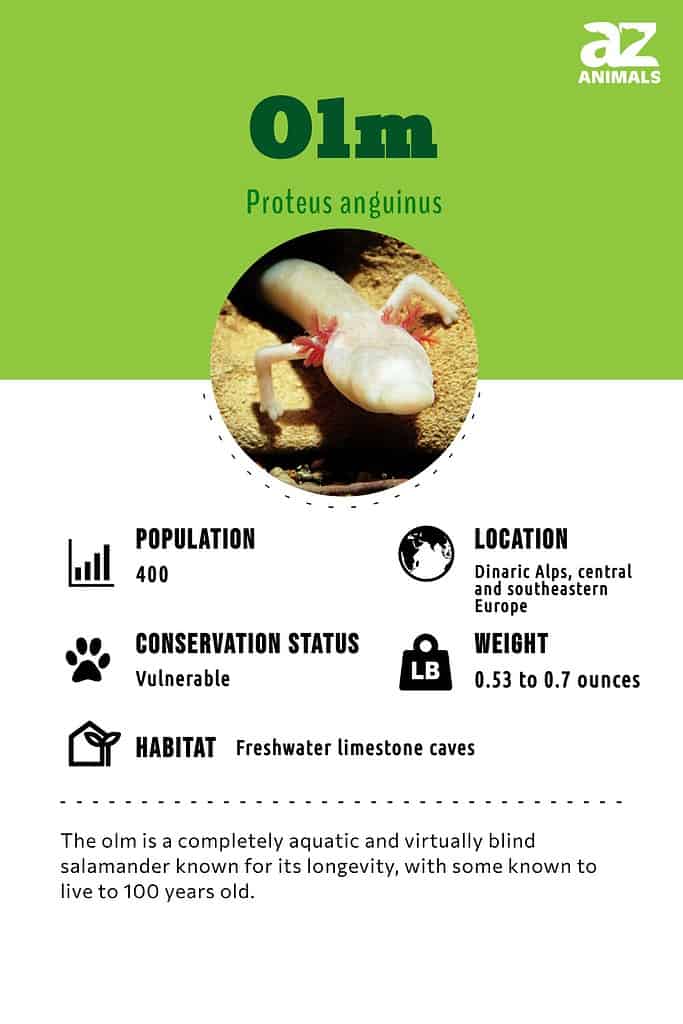
4 Incredible Olm Facts!
- Though the olm’s skin is pinkish or white if it’s kept in the darkness of the cave, if it’s taken out, it turns dark. If it’s returned to darkness, it reverts to its pink or white coloration.
- The olm can live without eating for at least six years.
- Even though it has lungs and can breathe air, the olm is considered completely aquatic.
- Being blind doesn’t stop the olm from being an efficient hunter. It uses an array of acute senses, including electrosensitivity, to find food.
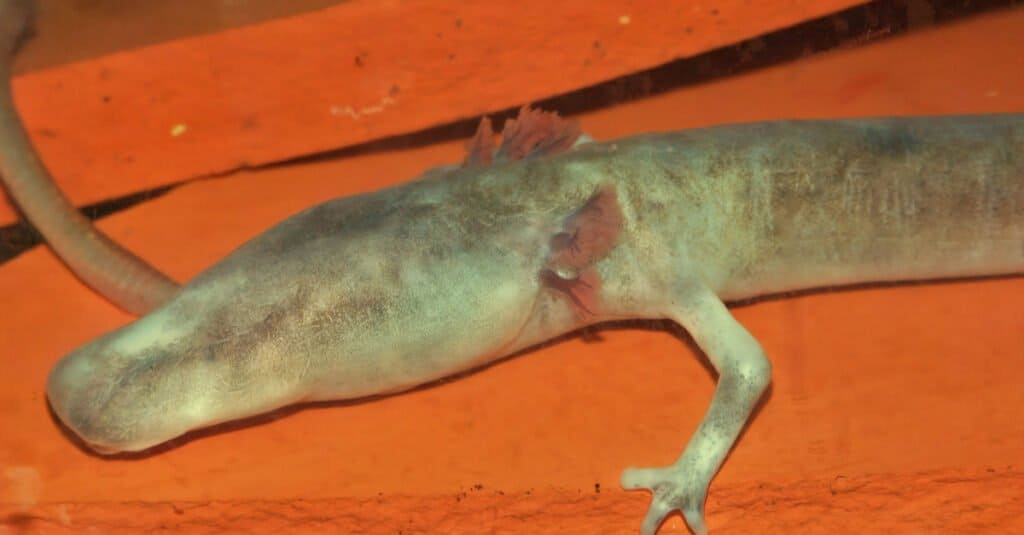
Olms have developed adaptations to help them hunt since their vision is so limited.
©Wirestock Creators/Shutterstock.com
Scientific Name
The olm’s scientific name is Proteus anguinus. Proteus comes from the Greek god who was able to change his shape at will, and anguinus comes from “anguis,” the Latin for “snake.”
It is the only member of its genus Proteus and belongs to the Proteidae family of aquatic salamanders present in the Balkan Peninsula and North America. It is part of the same order, Urodela, as the similar-looking axolotl, which belongs to the Ambystoma genus.
The olm is also commonly known as the proteus, cave salamander, and white salamander, with the local population referring to the animal as a “human fish.”
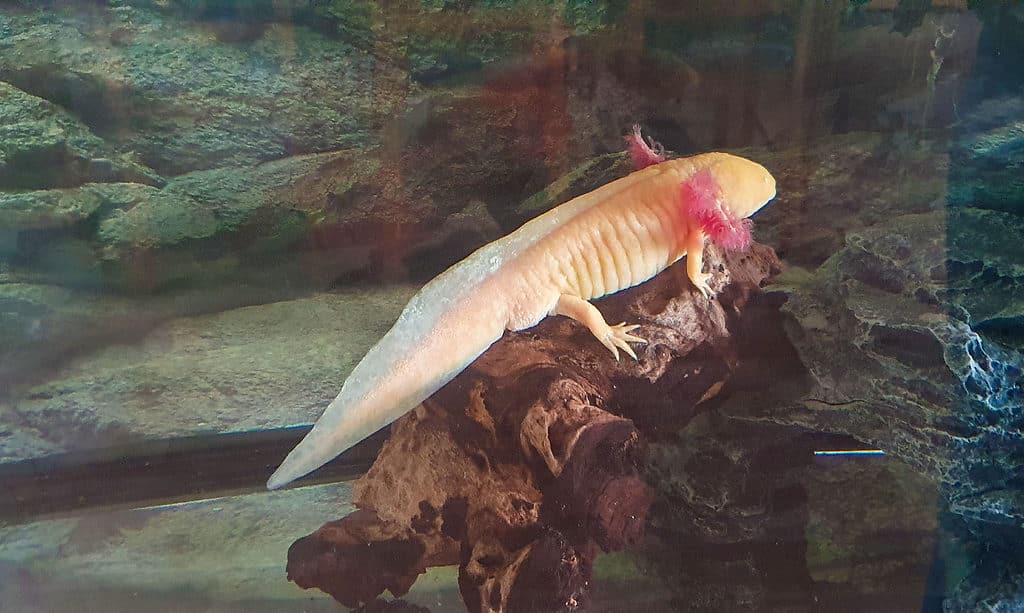
The olm belongs to the same order,
Urodela, as the golden albino axolotl.
©CheyennevB/Shutterstock.com
Types of Olms
Apart from the olm’s nominate subspecies Proteus anguinus anguinus, the black olm (Proteus anguinus parkelj) is the only subspecies recognized.
The black olm was first discovered in 1986 by Slovenian Karst Research Institute members and is endemic to a region smaller than 39 square miles of underground waters near Črnomelj in Slovenia. The black olm differs from the olm in its appearance: most obviously, it is dark brown or black and usually pigmented, and it also has a shorter head and longer body with 34–35 vertebrae.
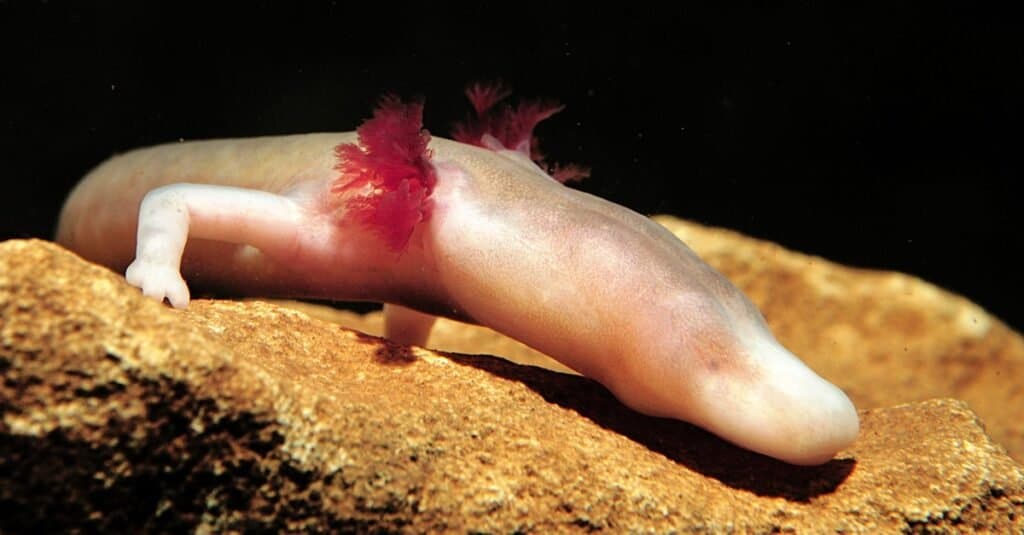
While the nominate subspecies is a pink color, the black olm subspecies is dark brown or black.
©lucacavallari/Shutterstock.com
Evolution and Origins
The olm’s origins can be traced back millions of years. It is a member of the Proteidae family, which was divided from the Rhyacotritonidae family of salamanders more than 124 million years ago. It is the only member of the genus Proteus, which split more than 87 million years ago from the genus Necturus consisting of waterdogs or mudpuppies native to North America. The olm established its cave habitats around 8.8 million to 20 million years ago.
This species was first referenced by naturalist Johann Weikhard von Valvasor in his 1689 book “The Glory of the Duchy of Carniola,” and referred to as a baby dragon following regional folkloric belief. Another naturalist, Josephus Nicolaus Laurenti, described it in 1768 and gave the olm its scientific name. Olms gained more attention over the years and were mentioned by Charles Darwin in “On the Origin of Species” published in 1859.
The olm has adapted to its environment in several different ways, including its reproductive cycle being only around every 12.5 years and in its appearance, including having fewer digits than other amphibians. Another adaptation the olm has developed is to lower its metabolism in times when food sources are in short supply. It can even start to feed on its own tissues and olms are also thought to cannibalize each other now and then. For more on its adaptations, see the Appearance and Behavior sections below.
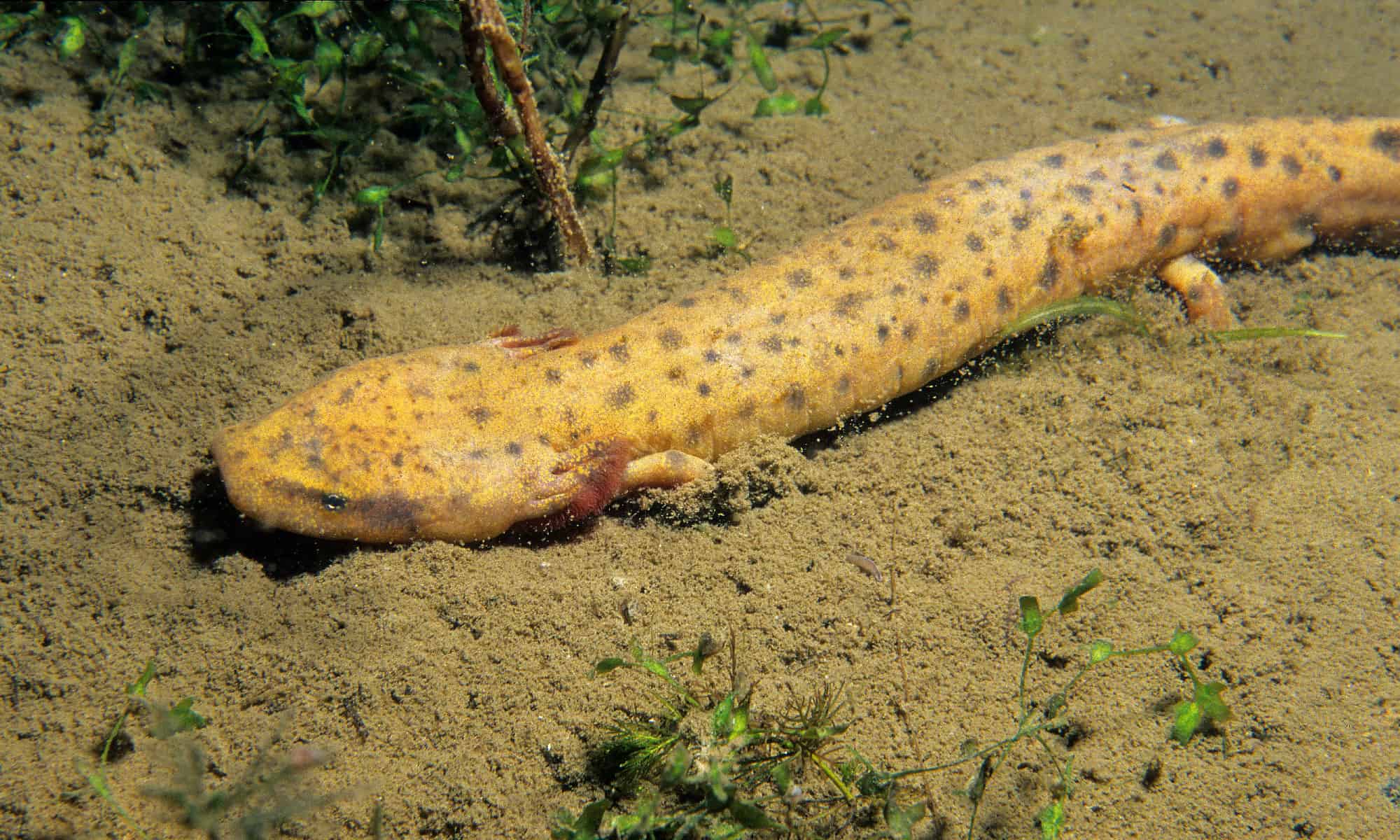
The olm genus split more than 87 million years ago from the
Proteidaefamily, which includes mudpuppies.
©RLS Photo/Shutterstock.com
Appearance
As befitting its scientific name, the olm has a long, sinuous body like a pigmentless snake, with furrows at the edges of the skeletal muscles. It has a short, flattened tail that has a fin that helps the animal swim. The olm seems to be evolving out of its limbs because they are very small and losing digits. For example, there are three digits on the animal’s front legs whereas most salamanders have four. There are even fewer digits on its back legs. It only has two, while other salamanders have five. Its skin is so thin and pale that its viscera can be seen through its abdomen. The skin is also protected by a layer of mucous. The fuzzy gills are red.
The olm’s head is long in proportion to its body, and it has a blunt snout and a small mouth with tiny teeth. Younger adult olms can be told from older ones because they may have yellow or red spots on their body, and their eyes are more easily seen. As the animal grows, its eyes deteriorate. Females are bigger than males, but it is hard to tell the sexes apart unless they are flipped over as the cloaca of the male is larger.
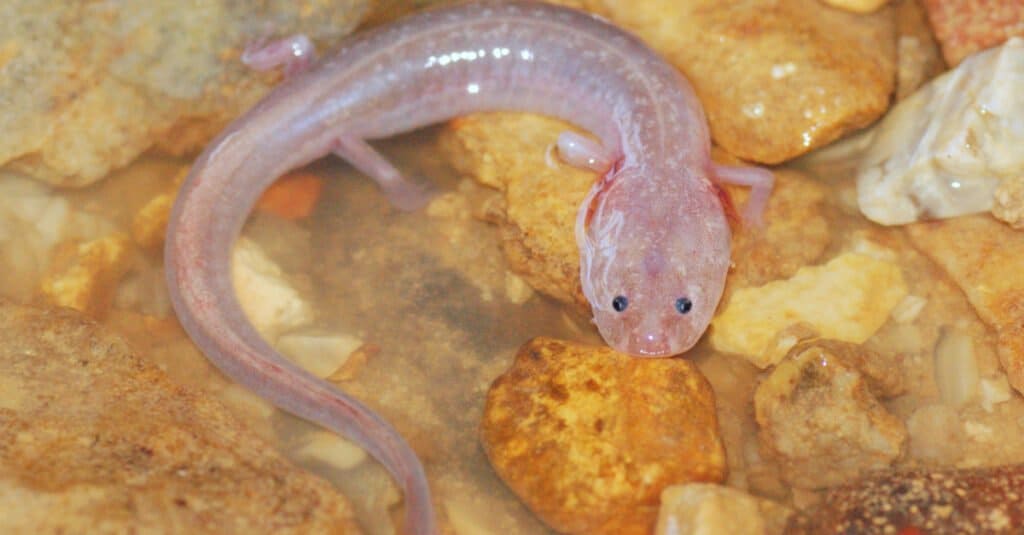
Younger olms may have spots on their bodies and more visible eyes compared to older olms.
©Matt Jeppson/Shutterstock.com
Behavior
Olms are gregarious save during the breeding season when both females and males stake out a territory. They gather in groups beneath rocks or crevices in the watery caves that are hard for people to access. They do not appear to migrate, and it’s not known how large an individual’s territory generally is. They are typically placid, and even males who are ready to breed are reluctant to fight. They usually simply display to drive away competitors.
Because they basically can’t see and do not need to see, cave salamanders have developed adaptations that allow them to hunt prey. They are able to sense tiny amounts of organic matter and can even tell which prey it came from. They can hear well, and sounds are also picked up by the animal’s lateral line. This is a line that’s often found on the sides of aquatic animals such as fish. It helps the animal sense motion, differences in pressure, and vibrations. Olms also have excellent hearing, both in the water and on the ground.
Other adaptations are a sharp sense of taste and heads that contain electrosensitive organs that can sense electrical fields. Though their vision is reduced, they can sense light and shy away from it. Some biologists believe the animal has light sensors in its skin.
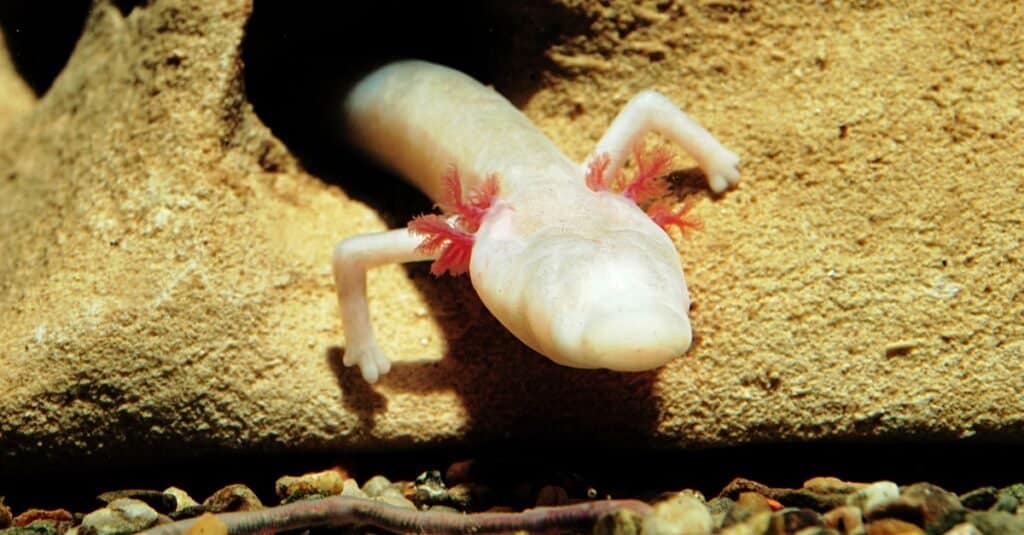
The olm may have virtually no vision but it can sense sound and movement through its body.
©lucacavallari/Shutterstock.com
Habitat
The olm is found in the watery caves of the Dinaric Alps near the Adriatic Sea, often at the entrances of the limestone caves. The waters are rich in oxygen, have a mildly acidic pH, and maintain temperatures of between 41 and 59 degrees Fahrenheit. The black olm subspecies lives in waters that are a bit warmer.
The temperature of the water also determines how the salamander is born and how quickly or slowly the larva grows. Olms can be found as much as 984 feet deep in a cave, but rain can wash them into streams.

The Križna jama cave in Slovenia is limestone like the olm’s habitat.
©Tomaž Planina / Creative Commons – License
Diet
The olm mostly eats insects, especially insects that hatch out of the water such as mayflies, stoneflies, and caddisflies, and insect larvae, but it will eat any prey it can catch and hold. It eats very small fish, worms, flies, and other small creatures such as the woodlouse, freshwater snails, and amphipods such as Niphargus. Also part of the olm’s diet are tiny fish and eggs. They will readily take bits of raw meat. It also eats detritus.
Though it has tiny teeth, the cave salamander doesn’t chew but swallows its prey whole. It eats a great volume of food if it’s available and is able to store food to the point where it can go for years without eating. One of the adaptations the olm developed to deal with food scarcity is the ability to lower its metabolism. It can even start to feed on its own tissues. Olms are also thought to cannibalize each other now and then.
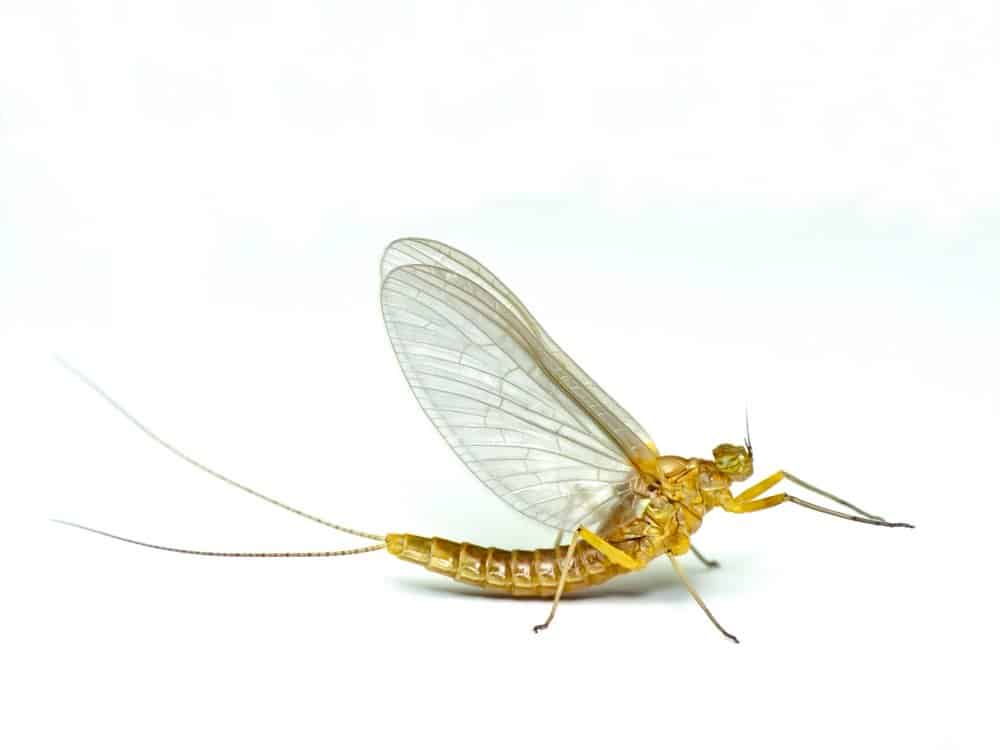
Mayflies form part of the olm’s diet.
©Dimijana/Shutterstock.com
Predators and Threats
While olm doesn’t have regular predators in its small habitat, it is threatened by human activity, even though humans have strived to preserve it by law for close to 100 years. It is sensitive to pollutants such as fertilizers and pesticides, and it is collected, illegally, for the pet trade.
Now and then an olm will be eaten by a fish or other animal that got lost in its cave or will be eaten by another olm.

Water pollution is one of the threats to the olm.
©Eurico Zimbres / CC BY-SA 2.5 – License
Reproduction, Babies, and Lifespan
People have only seen olms breed in captivity. They only breed once every 12.5 years, and both sexes are not reproductively mature until they are about 14 years old. During this time, males claim a territory and defend it as they wait for a female to pass by. The sexes can be told apart at this time because the male’s cloaca is swollen and he has lines along his tail, his fins are a little curled, and the color of his skin is brighter.
When a female enters the male’s territory, they have a courtship ritual that ends with him depositing a packet of sperm and her taking it up into her cloaca and storing the sperm in a spermatheca. Then, the sperm fertilizes her eggs. Females only mate with one male but males mate with more than one female.
The female olm then establishes her own territory at a distance from the male’s. She carries the fertilized eggs for two to three days and then starts to lay them under a rock. She can lay eggs for as long as 25 days. There are usually between 35 and 70 eggs. They are 0.16 to 0.2 inches around at first then swell up to 0.31 to 0.35 inches as they take on water. The female guards them for two to six months. The temperature of the water plays a role in determining when the eggs hatch. Eggs incubated in colder temperatures hatch later than eggs incubated in warmer temperatures. When the eggs hatch the larvae, which are about 0.8 inches long, are independent.
The olm tadpoles don’t undergo metamorphosis but are smaller versions of their parents. Some scientists believe that a proteus can give birth to live larvae if the water is cold and only lays eggs when the water is a bit warmer, but this is anecdotal.
Olms can live on average for around 68 years in the wild, but it’s estimated that they are capable of living for more than 100 years. It’s thought they live so long due to the cool water of its environment and its slow metabolism.

Breeding among olms has been observed in captivity.
©Tatiana Dyuvbanova/Shutterstock.com
Population and Conservation
Scientists believe there are at least 400 olms in the world. Their habitat makes them difficult to study, but they are bred in captivity in Germany and France and can be seen at Croatia’s Zagreb Zoo.
The olm is classified as Vulnerable on the International Union for Conservation of Nature’s Red List.
View all 66 animals that start with OOlm FAQs (Frequently Asked Questions)
Are olms herbivores, carnivores, or omnivores?
Olms are carnivores, meaning they eat other animals.
What kingdom do olms belong to?
Olms belong to the kingdom Animalia.
What phylum do olms belong to?
Olms belong to the phylum Chordata.
What class do olms belong to?
Olms belong to the class Amphibia.
What family do olms belong to?
Olms belong to the family Proteidae.
What order do olms belong to?
Olms belong to the order Caudata.
What genus do olms belong to?
Olms belong to the genus Proteus.
What type of covering do olms have?
Olms are covered in permeable skin.
In what type of habitat do olms live?
Olms live in underground watery caves.
What is the main prey for olms?
Olms prey on insects, worms, and snails.
What are some distinguishing features of olms?
Olms have elongated bodies and undeveloped limbs.
What are some predators of olms?
Predators of olms include fish, toads, and birds.
What is the average clutch size of an olm?
Olms typically lay 10 eggs.
What is an interesting fact about olms?
The olm can live without eating for at least six years.
What is the scientific name for the olm?
The scientific name for the olm is Proteus anguinus.
What is the lifespan of an olm?
Olms can live on average for around 68 years, but it’s estimated that they are capable of living for more than 100 years.
How fast is an Olm?
An olm can travel at speeds of up to 5 miles per hour.
How do olms have babies?
Olms lay eggs.
What is an olm?
An olm is a blind salamander that lives in the fresh water of European caves. It is famous for being aquatic and for its very long life, which can span a century. Scientists believe that the cave salamander lives as long as it does because of the cool water of its environment and its slow metabolism.
How many olms are left?
There are at least 400 olms left in the world. Its conservation status is listed as Vulnerable.
Is an olm an axolotyl?
An olm and the axolotyl are not the same animal, though they are both types of aquatic salamanders. The olm lives in Europe and the axolotyl lives in Mexico. Both are aquatic and have neotenic traits. This means they’ve held on to traits they had when they were larvae, such as gills.
Are olms blind?
Because they spend their lives in caves, olms are basically blind, though they have eyes. However, their eyes are vestigial and covered with skin and can only detect light and dark.
Do olms eat?
Olms do eat, though they can go without food for the better part of a decade. They basically eat anything they can catch and swallow.
Why are olm eggs called salamander eggs?
Olm eggs are called salamander eggs because the olm is a type of salamander.
How big is an olm?
An olm ranges from 8 to 12 inches long, though they can grow as long as 16 inches.
Can you keep an olm as a pet?
Some people would like to keep an olm as a pet, but selling the cave salamander as a pet is illegal.
Thank you for reading! Have some feedback for us? Contact the AZ Animals editorial team.
Sources
- National Georgraphic, Available here: https://www.nationalgeographic.com/science/article/the-olm-the-blind-cave-salamander-that-lives-to-100
- New Scientist, Available here: https://www.newscientist.com/article/mg22830501-000-meet-the-weird-amphibian-that-rules-the-underworld/
- Animal Diversity Web, Available here: https://animaldiversity.org/accounts/Proteus_anguinus/
- Edge of Existence, Available here: http://www.edgeofexistence.org/species/olm/
- Wikipedia, Available here: https://en.wikipedia.org/wiki/Olm
- Amphibia Web, Available here: https://amphibiaweb.org/species/4229
- Britannica, Available here: https://www.britannica.com/animal/olm
- Xinhua Net, Available here: http://www.xinhuanet.com/english/2020-01/11/c_138695353.htm

















